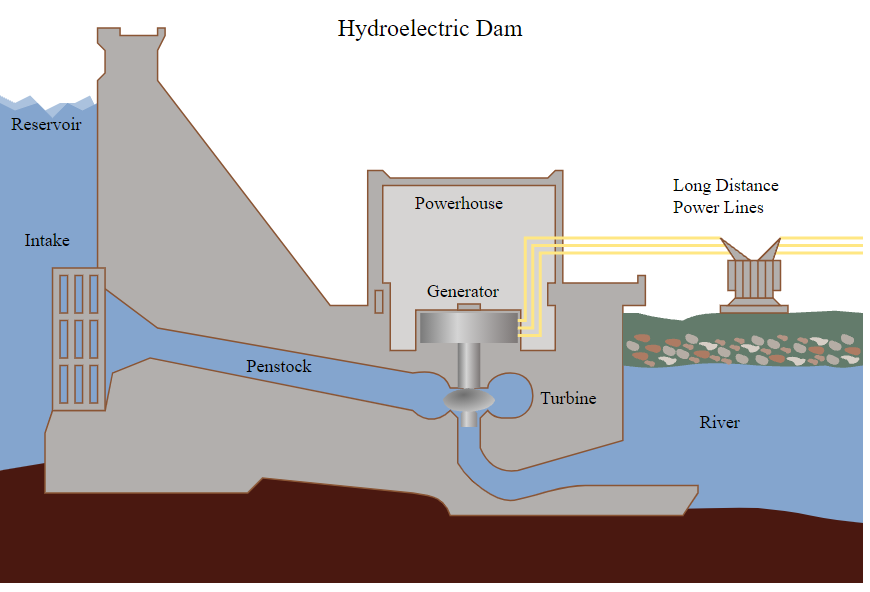
What is hydroelectricity? Explain the basic principle of generation of hydroelectricity with the help of a labeled diagram.
(a) State two advantages of producing hydroelectricity.
(b) State two disadvantages of producing hydroelectricity.
Answer
462.6k+ views
Hint:Energy can be developed in various forms. These forms include hydro energy, wind energy, solar energy, thermal energy, and chemical energy. In this question, they have asked about how electricity is generated from water that is nothing but hydroelectricity. Among the various other forms to generate electricity hydroelectricity is considered to be most cost-effective.
Complete step by step answer:
Energy derived from the flowing water is said to be hydroelectricity. This hydro energy is derived from the hydroelectric power plant. The hydroelectric power plants are nothing but the dams on the river that store the water in a reservoir. They use this water that is stored in the reservoir to generate electricity. Let us see the principle of hydroelectricity with the help of a diagram.

The principle behind hydropower is we use the water from the reservoir to drive the turbines. We have already said that hydropower plants require a dam. This dam is placed in the area where there is a large amount of water flowing, mostly rivers. This dam collects water and sends it to the turbine.
The turbine is a device that is coupled with an alternator and converts mechanical energy into electrical energy. The turbine is connected by a shaft and this is connected to the generator. The water falling in the turbine will rotate the turbine blades and therefore electrical energy is generated.
(a) The advantages of hydroelectricity are listed below:
-It provides irrigation to the local farmer.
-It does not cause any damage to the environment
(b) The disadvantages of hydroelectricity are listed below:
-It requires high capital and in return, it provides a low rate of return
-A large area that is used for agriculture is submerged underwater.
Note:The most widely and crucially used source of generating electricity is hydroelectricity. This is a renewable source of energy. There are about \[197\] hydropower plants. It generates about \[25\,MW\] of energy. Hydropower plants also have another facility of pumped storage in which water is kept as a reserve for some periods of peak power demand.
Complete step by step answer:
Energy derived from the flowing water is said to be hydroelectricity. This hydro energy is derived from the hydroelectric power plant. The hydroelectric power plants are nothing but the dams on the river that store the water in a reservoir. They use this water that is stored in the reservoir to generate electricity. Let us see the principle of hydroelectricity with the help of a diagram.

The principle behind hydropower is we use the water from the reservoir to drive the turbines. We have already said that hydropower plants require a dam. This dam is placed in the area where there is a large amount of water flowing, mostly rivers. This dam collects water and sends it to the turbine.
The turbine is a device that is coupled with an alternator and converts mechanical energy into electrical energy. The turbine is connected by a shaft and this is connected to the generator. The water falling in the turbine will rotate the turbine blades and therefore electrical energy is generated.
(a) The advantages of hydroelectricity are listed below:
-It provides irrigation to the local farmer.
-It does not cause any damage to the environment
(b) The disadvantages of hydroelectricity are listed below:
-It requires high capital and in return, it provides a low rate of return
-A large area that is used for agriculture is submerged underwater.
Note:The most widely and crucially used source of generating electricity is hydroelectricity. This is a renewable source of energy. There are about \[197\] hydropower plants. It generates about \[25\,MW\] of energy. Hydropower plants also have another facility of pumped storage in which water is kept as a reserve for some periods of peak power demand.
Recently Updated Pages
Master Class 9 Social Science: Engaging Questions & Answers for Success

Master Class 9 Science: Engaging Questions & Answers for Success

Master Class 9 English: Engaging Questions & Answers for Success

Master Class 9 Maths: Engaging Questions & Answers for Success

Master Class 9 General Knowledge: Engaging Questions & Answers for Success

Class 9 Question and Answer - Your Ultimate Solutions Guide

Trending doubts
Which places in India experience sunrise first and class 9 social science CBSE

Fill the blanks with the suitable prepositions 1 The class 9 english CBSE

Write the 6 fundamental rights of India and explain in detail

Difference Between Plant Cell and Animal Cell

What is pollution? How many types of pollution? Define it

What is the Full Form of ISI and RAW




